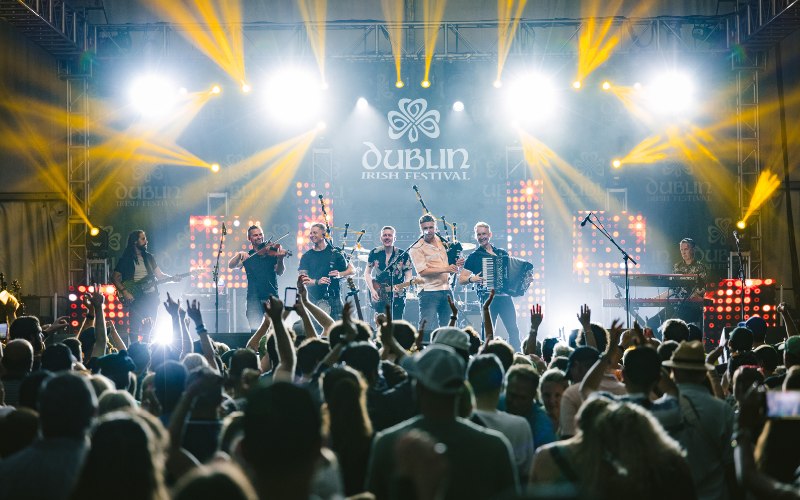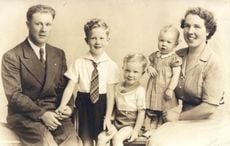With instruments ranging from African drums, Irish bagpipes and Celtic fiddle to trombones and Cajun-style accordions, there is something for everyone on What's the Rumpus, the phenomenal new CD from Gaelic Storm.
If you can't find something to tap a toe to on this collection, then you probably don't like music. The collection opens with the title track, a sizzling Cajun toe-tapper that was born to breathe on the wide open spaces of a summer festival. "They were charging me a cover on my own front door," they sing, tipping the listener off to the wild party tunes that await.
"The Samurai Set" and "Death Ride to Durango" are spirited, unrelenting reels that display the formidable chops of this touring warhorse. "If Good Times were Dollars" is a cheeky country cousin to Barenaked Ladies' "If I Had $1,000,000." Thank God they have just enough charm to pull it off.
In one of the most brilliant uses of bagpipes, the band busts out a reggae rhythm for the pipe solo on "Floating the Flambeau." Try playing this hot jam at your next summer party!
The CD is the latest release in what the band is hoping is a string of successes. Their eponymous first album reached number five on Billboard's World Music chart in 1998. Gaelic Storm continues to consistently climb to the top of the Billboard charts.
The band's 2006 release Bring Yer Wellies debuted at number two on the Billboard World Chart. Their music has been featured on everything from movies to greeting cards. Gaelic Storm was featured in a special "soundcard" greeting card for St. Patrick's Day last year with their original song "Kiss Me I'm Irish" in between.
The band formed on St. Patrick's Day of 1996, when co-founders Patrick Murphy of Cork City (vocals, piano, accordion, spoons, harmonica) and New Yorker Steve Wehmeyer (bodhran, vocals, didgeridoo) officially joined forces with Steve Twigger of Coventry, England (vocals, guitar, mandolin, bouzouki), at O'Brien's pub in Santa Monica, California.
Their first performance was such a hit that the crowd refused to let them off the stage for the next act. In 1997, Gaelic Storm was catapulted out of their formative pub haunts by an appearance in the blockbuster film Titanic.
Cast as the "party band" in the steerage scene, they landed the part while still drinking pints and playing weekly at O'Brien's. After the film's release, the band was met by huge crowds on their first tour.
Although Wehmeyer no longer tours or records with Gaelic Storm, he continues to co-write with the band. New members are Ryan Lacey (drums and world percussion) Pete Purvis (pipes and flutes) and fiddler Jessie Burns.
"We are a party band in the good sense of the word," explains Steve Twigger during our exclusive chat. "We enjoy what we do and I think it comes out in the live show. If you come to our show and you are troubled by anything, you can put your troubles to one side and we'll put a smile on your face."
In these dog days of summer, when it is easy to get depressed about your falling house price and the inflation that chokes off your summer fun, What's the Rumpus is just the thing you'll need to chase those dark clouds away in our summer skies. I spoke with Twigger about the infectious Gaelic Storm sound. Here's how it went.
There seems to be something for everyone on this album. You probably don't like music if you don't like something on this.
I really enjoy your characterization. To get to that space in the band to let it flow out of you without worrying about where it sits is a really good place to be.
Each one of us has various influences. We opened a few beers and each one of us brought an hour's worth of music that inspired them and then set about putting this feeling together. It was really a great process.
What kind of things did the band bring to the table?
Some, like Ryan our drummer, had some amazing soul music that we never knew he was into. He also brought hip hop and rock songs. Patrick played some old Depeche Mode and Jayhawks. I played some very heavy rock music. I grew up with the Clash and ska.
I think all of us are influenced by the Celtic jam band Kila. We didn't try to pigeonhole our sound in any way. I mean, we know our audience and are comfortable with where we are at.
Did the end product surprise you?
It didn't surprise me at all. We didn't think of a sound that we were going for. In this process, you sort of put your head down and you work. Then you push your chair back and listen. If it's cohesive, it's cohesive. It is what it is. This is a snapshot of where our lives are right now.
Describe the band to someone who had never heard of you.
In the 12 years I have struggled with answering that question. Over the course of time, we have had lighthearted references to "Guinness of the ears." For this album, I guess I would call it a three ring circus of different characters known as songs that are bouncing around.
Where is the band based now?
All over the place. We started in Santa Monica a few years back. I live in Austin, Texas, our piper is in Canada, and the drummer is in Chicago.
How do you keep a band together in all of those distances?
It's a strength. We are on the road 200 days out of the year. So, we are not in one another's pockets when we are off the road.
How long did it take you to put the album together?
The writing of the songs took a few years, but some were written in a couple of hours. It was 14 hour days for a couple of months. I personally like working with a deadline. I was in advertising before this and you have a real tight deadline. It works well for creativity.
"Don't Let the Truth Get in the Way of a Good Story" is a good song and an even better title. How did that come about?
Patrick is a natural and gifted storyteller. He could make a tale about going to the bathroom interesting. I could see over the years how he stretched the truth for entertainment value. He creates this wonderful mixture of a grain of truth with elasticity without being a con artist about it.
How did reggae make its way into the mix?
We just started jamming with bagpipes and played with beats and guitar licks around it. We fired it up and saw what happened.
What do you think of the state of Irish and Celtic festivals and the music scene within them?
We have grown in the circuit. We have seen festivals grow from nowhere. Our crowds have been getting bigger and bigger, while some are wilting.
I think the scene needs a good healthy dose of new blood, and I think we have some good bands coming up trying to show guys like us their stuff. We have wonderful old school stuff that is dying a bit.
Tommy Makem's passing in particular was very significant, I think. Bands like ourselves were hugely influenced by the Clancy Brothers, and as guys like him move on, it is up to bands like us to carry on the good word.
A lot has been written about the poor economy and its effect on the musicians playing live. Do you see any of that?
I think it's tough in some ways. We have a pretty established fan base that supports us, but a lot of bands that are barely hanging on will go by the wayside in this economy. I think some of the shows with the higher ticket prices will suffer.
That said, I think in these uncomfortable times, people need their entertainment more now than they ever did. I think the festivals are a great way to connect to something real and yet they deliver a great value for the money. You can see a whole stream of bands for the price of one concert ticket.




Comments